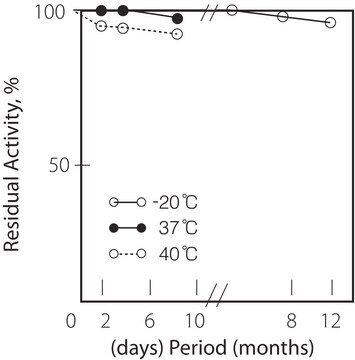G0774
Glycerokinase from Bacillus stearothermophilus
buffered aqueous solution, ≥75 units/mg protein (biuret)
Synonyme(s) :
ATP:glycerol 3-phosphotransferase, Glycerol Kinase
About This Item
Produits recommandés
Source biologique
Bacillus sp. (Bacillus steaarothermophilus)
Pureté
≥5.0 mg protein/mL (biuret)
Forme
buffered aqueous solution
Activité spécifique
≥75 units/mg protein (biuret)
Conditions de stockage
dry at room temperature
Couleur
beige
Application(s)
life science and biopharma
Température de stockage
2-8°C
Informations sur le gène
Bacillus sp. ... glpK(89613566)
Vous recherchez des produits similaires ? Visite Guide de comparaison des produits
Description générale
Glycerol kinase is encoded by the GK gene on chromosome Xp21.2. Glycerol kinase is predominantly active in the liver.
Application
Actions biochimiques/physiologiques
Définition de l'unité
Forme physique
Mention d'avertissement
Danger
Mentions de danger
Conseils de prudence
Classification des risques
Resp. Sens. 1
Code de la classe de stockage
11 - Combustible Solids
Classe de danger pour l'eau (WGK)
WGK 3
Point d'éclair (°F)
Not applicable
Point d'éclair (°C)
Not applicable
Équipement de protection individuelle
Eyeshields, Gloves, type N95 (US)
Certificats d'analyse (COA)
Recherchez un Certificats d'analyse (COA) en saisissant le numéro de lot du produit. Les numéros de lot figurent sur l'étiquette du produit après les mots "Lot" ou "Batch".
Déjà en possession de ce produit ?
Retrouvez la documentation relative aux produits que vous avez récemment achetés dans la Bibliothèque de documents.
Notre équipe de scientifiques dispose d'une expérience dans tous les secteurs de la recherche, notamment en sciences de la vie, science des matériaux, synthèse chimique, chromatographie, analyse et dans de nombreux autres domaines..
Contacter notre Service technique







